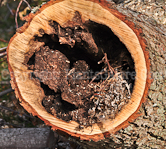 I
once had an otherwise healthy looking tree fall down on
a nice, calm summer day. Once it was on the ground,
however, we could see that the center of the trunk was
totally rotted. The canopy of foliage had appeared to be
dark green and the leaves looked great. What happened?
I
once had an otherwise healthy looking tree fall down on
a nice, calm summer day. Once it was on the ground,
however, we could see that the center of the trunk was
totally rotted. The canopy of foliage had appeared to be
dark green and the leaves looked great. What happened?
It was the result of an
invasion by a very common fungus that causes rot in the
heart wood of trees. Remember that the true "living"
tissue on a tree trunk occurs at that thin layer called
the
cambium just beneath the bark. Tissue in the cambium
is able to produce new cells (xylem and
phloem) but the
cells toward the inside of the tree no longer have that
ability.
So, unlike we animals,
part of a tree, the "dead" wood on the inside can rot
away and not really impact the tree as long as the
cambium layer is not involved. How does this work?
Rot is nature's way of
breaking down complex organic tissue into its component
parts. The key organism that does this rotting are
fungi. They "eat" the organic matter and turn into what
looks like fine textured sawdust. To do this effectively, the fungi
needs a good supply of moisture so, the rot may be
encouraged by the presence of some type of damage which
allows moisture to enter through the bark.
It would seem logical
that, once rot gets started, the whole tree would rot
away. However, this does not happen because another
characteristic of trees is that they have the ability to
set up barriers and "compartmentalize" problems that
occur in a branch or in the trunk to protect the rest of
the organism. The rot will progress to a certain point
but the tree will eventually set up a chemical barrier
that will put a stop to it. Unfortunately, this only
leaves a hollow, weakened place in the trunk which makes
it more liable to break off.



